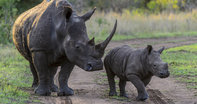
Introduction
Armoured with strong hides and a menacing horn, the African rhinoceros can graze undeterred alongside resting lions in the bushveld of South Africa.
They are characterised for the great horns that protrude from their heads, which have also been the reason for these animals being poached by hunters. In the Kruger National Park in South Africa, the white rhino (Ceratotherium simum) can be found mainly between the Sabie and Crocodile rivers in woodland areas.
The black rhino (Diceros bicornis) prefer to live among thorny thickets and bushveld located between Skukuza and Pretoriuskop in the Southern Kruger region. Black rhinos can also be found in the Lower Sabie and Crocodile areas to the south.
How and When do Rhinos Sleep?
Alarmingly, the African rhinoceros are deep sleepers and can fall asleep either standing up or lying down. They sleep up to 8 hours a day, which they can break up into smaller naps.
During a deep sleep, the African rhinoceros tends to lie flat down with their feet and legs curled up to the side. In the bushveld in South Africa, you can spot a rhino sleeping beneath a shady tree during the heat of the day. Rhinos are also approachable while in a deep sleep, because they won’t even realise you are there!
How do Rhino Keep Cool?
The African rhinoceros prefer to move around at night when it is much cooler. The hot sun during the day in South Africa can be unbearable, so the rhinos prefer to rest in the shade or wallow in a cool mud pit.
The mud is great for protecting their skin against the sun and unwanted parasites. Rhinos also take every opportunity to quench their thirst by the watering hole.
What is the Rhino Horn Made of and Why is it in Such Demand?
The horn of the African rhinoceros is made up of a tissue called keratin, found in the make-up of nails, hair, teeth and hooves. The horn is mistakenly believed in some cultures to contain medicinal properties leading to a devastating decrease in the rhino population, due to illegal poaching.
The horn was also used to create ceremonial dagger sheaths and handles in Yemen. However, this practise has since been banned. South Africa has launched many conservation programmes to help protect and save the African rhinoceros, including dehorning rhinos to deter poachers.
Wildlife rehabilitation centres home orphaned baby rhinos whose mothers have fallen victim to poachers. These precious baby rhinos are monitored via webcams and are dehorned when they are old enough for their continued safety.
What are the Differences Between Black and White Rhinos?
The colour of the two African rhinoceros species are the same. The name of the White rhino was based on its wide of ‘wyd’ mouth shape that is used for grazing.
The Black rhino has a hooked mouth which is used for browsing and eating off tree shrubs and bushes found in the wild in South Africa.
These dietary preferences make the White rhino a grazer and the black rhino a browser, and the reason for the different mouth shapes. The white rhino is also bigger than the black rhino. Read more about White Rhino and Black Rhino
 A bronze-on-stainless-steel marvel, it employs the form of the majestic rhino to illustrate the beauty of dualism....
A bronze-on-stainless-steel marvel, it employs the form of the majestic rhino to illustrate the beauty of dualism.... Learning about the mammals of South Africa is now so much easier for all South Africans - SouthAfrica.co.za is an excellent source of inform...
Learning about the mammals of South Africa is now so much easier for all South Africans - SouthAfrica.co.za is an excellent source of inform...